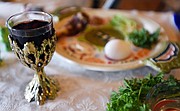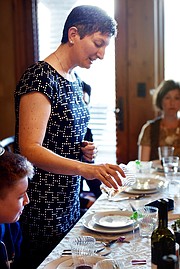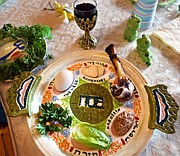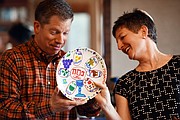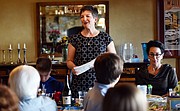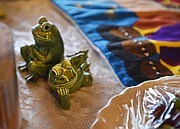Celebrating the spring festival of Passover
On Monday evening at just before 6:30 p.m., guests begin making their way to the Whitefish home of Marc and Rabbi Francine Roston for a celebration of the start of Passover, the feast of unleavened bread, which celebrates the liberation of the Israelites from Egypt.
A larger community celebration was held April 11, but this first night of Passover was more of a family event. Charlene Green, Francine’s mother, came in from Detroit for the holiday, bringing with her 49 pounds of kosher chicken and lamb.
“Passover is the spring festival during which the Jewish people celebrate freedom and renewal. During Passover we tell the story of being liberated from slavery in Egypt and remind ourselves of the gift of freedom,” said Rabbi Roston.
Passover began the evening of April 10, and will continue until Tuesday, April 18. Rabbi Roston said that in Israel Passover is a seven day festival, as mandated in the Bible, but Jewish people living outside of Israel add an extra day to their observance.
“Passover is one of the most highly observed festivals along with Hanukkah, so this time of year is sacred,” she said.
The table was set for 21 and embellished with flowers and frogs. The frogs are a symbol of the plagues sent to Egypt to prompt the pharaoh to release the Israelites as told in the book of Exodus. Rabbi Roston has been collecting them for 15 years. The entire Seder meal is highly symbolic, from the decorations to the dishes served.
As Rabbi Roston stands to welcome guests to her home she picks up her glass of wine and pours some of the wine on the table. This is the first spill of the night, and it is meant to make the guests feel more welcome. Anything that goes awry after this is easier because the first spill had already happened.
The Seder meal begins with Rabbi Roston showing the Seder plate she made with her daughter at Stumptown Art Studio in Whitefish and giving an explanation of the various dishes that will be served over the next hours. She jokes that some people have made it a challenge to see how long their Seder meals can last, sometimes going as late as 2 a.m. This one only lasted until around 11:30 p.m.
The various dishes were bookended by prayers and readings, by laughter and many songs. It is the Jewish tradition to say grace after the meal, rather than before. As the meal concludes the Blessing After the Meal is read: “They who sow in tears shall reap with songs of joy.”
“Passover for me, involves a lot of preparation,” said Rabbi Roston. “I have to plan to have special food, and have foods that are kosher. Traditionally people go through a process of cleaning their homes to remove any trace of crumbs or flour. So Passover is a process of cleaning, but then also there are the preparations a person makes spiritually to celebrate freedom. I ask myself, ‘What am I releasing myself from this year? What do I want to let go of?’ It takes a lot of work to prepare, but ultimately it’s a very happy, joyous family time.”
The meal concludes with desserts, like Matzah Brittle, long conversations and many smiles.
“We are the minority here in Montana, but any time I speak with someone out in the community about the holiday, they are interested to learn and encouraging of our practice,” said Rabbi Roston. “What’s interesting is we don’t live in an area with a lot of Jewish people, but we do live in an area with a lot of religious people. And religious people, from my experience, are respectful of other religions. Personally I enjoy the opportunity to share our traditions.”











